What does F-35 not like in Australia?
The Wikipedia article on the F-35 fighter was translated into the 53 language! And along with it, a chapter was devoted to the confrontation between the analytical center “Air Power Australia” and the aircraft manufacturing corporation “Lockheed Martin”. According to the information available, Air Power Australia, in the person of its founder, Carlo Koppa, expressed its distrust of the latest American F-35 fighter, Lightning-2, and almost accused the United States of betrayal in connection with the refusal to transfer to its allies the normal F-fighter 22.
It was Carlo Kopp who owns the famous comparison of Lightning and Raptor with a scooter and a motorcycle.
The apotheosis was a publication claiming an official document and containing a table showing the most important characteristics of the five most modern fighters: the Russian Su-35 and PAK FA, the Chinese Chengdu J-20 and a pair of scandalous products of the American aircraft industry - F-22 and F-35. Four of the five cars presented claim the high title of "fifth-generation fighter." Fifth - Su-35 - has such a powerful combat potential that, being an 4 ++ generation aircraft, it can safely compete with any “Raptor”.
The table quickly spread across the expanses of the Internet, becoming an argument in disputes over the title of the best fighter of the new generation.
The above results are completely atypical for an English-speaking source: according to the results of the table, the Sukhoi T-50 (PAK FA) was confidently taking the lead. The second place with the same result was shared by Su-35 and F-22 Raptor. In third place was the Chinese.
However, the "second" and "third places" does not happen. In air combat, silver medals are not given - “second place” means death in a fight with a champion.
The “outsider” of the list finished with a big lag - F-35, who collected as many as 8 penalty points in most of the selected categories.
The backlog of Lightning from the Raptor or the PAK FA looks quite convincing - the lightweight fighter was created as a cheaper, simplified version of the fifth generation designed for the mass replacement of F-16 and F / A-18 fighter-bombers, as well as VTOL AV-8 and A-10 attack aircraft.
Another thing is curious: how could a plane described in detail, already released in the number of 100 units, “lose” in a disastrous way to the Chinese J-20, existing only in the number of three experimental prototypes with secret TTX? Showy secrecy in this case indicates that there is nothing to brag about yet.
Hellish mix of American "Raptor" and the closed Russian project MiG.144 ... The Chinese managed to make an uninterrupted cockpit lantern, but no other "innovations" were noted. The aerodynamic design of the duck with CIP, coupled with the enormous size of the fighter itself - all this contributes little to its low profile. And the fact that China still buys Russian fighter jets shows that there is no Chengdu supercar - the Chinese J-20 is just a dream of a “fifth generation”. To compare this scarecrow with already existing machines, moreover, to confidently pass a verdict in his favor, is extremely incorrect.
The remaining findings of Mr. Kopp are also not credible, and in some cases look very doubtful. I propose to carefully analyze the table to understand - what does all this mean?
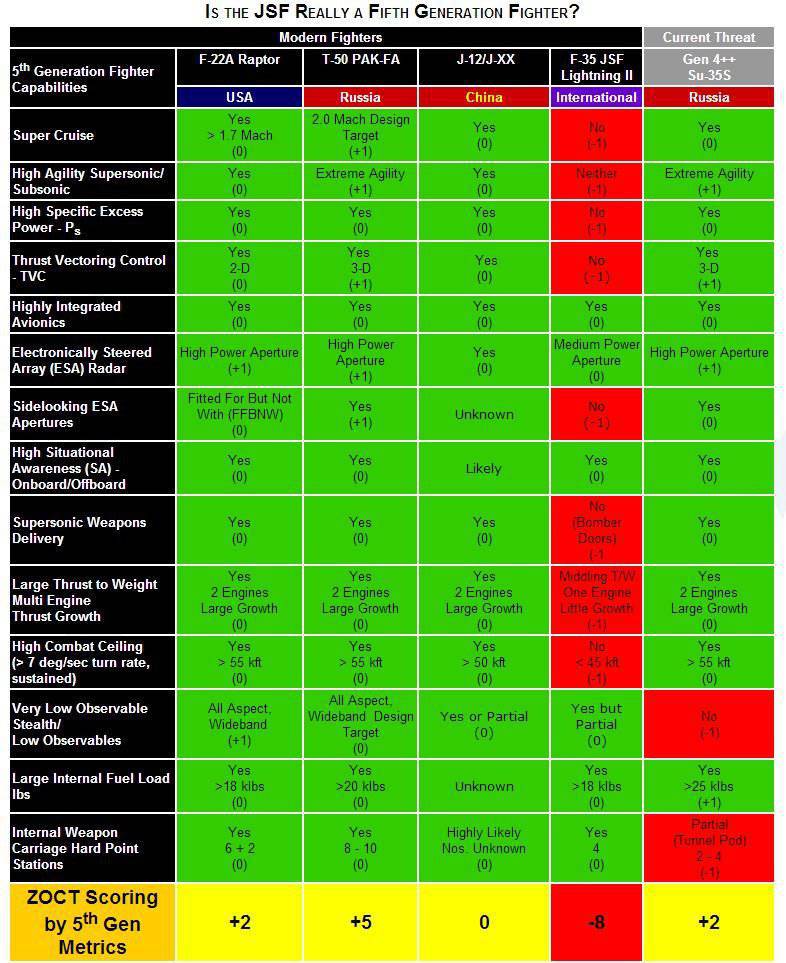
1. Cruising supersonic.
F-35 immediately received a penalty score. In this case, the Kopp is not too far from the truth - there are justifiable doubts that the single-engine F-35 is able to go to supersonic without switching on the afterburner.
The best was recognized by the PAK FA, whose design, according to experts, is designed for the 2 Mach cruising speed.
2. Over-maneuverability.
F-35 again received a penalty score. The best performance is in Russian Su-35 and PAK FA. In this case, Kopp is undoubtedly right.
However, an overly scornful attitude towards LTH F-35 is fraught for two reasons. First, according to the developers, Lightning retains control at angles of attack up to 53 ° and is capable of maneuvering with overloading up to 9g - like any normal fighter of its class. Secondly, in a real combat situation, the Lightning will have an advantage over any 4 generation fighter (even the Su-27 and Su-35) due to the internal suspension of the weapons and, in view of this, removed piloting restrictions with suspended ammunition (see item number XXUMX).
3. Excess thrust.
Excess thrust depends on the particular flight mode selected.
For example, the light-engine Cessna for flying at an altitude of 800 m with a speed of 140 km / h requires power 60 hp. Max. engine power "Cessna" is 100 hp - therefore, 40% engine power is an “overload” and can be spent on increasing the speed / altitude of the flight, or making a maneuver with an overload of no more than 1,6g.
There is no explanation in the Carlo Koppa table. It remained unclear, for which same "Lightning" slapped "minus". Probably just in case.
4. Driven vector thrust.
The “raptor” is equipped with a motor with the OBE in the same plane (2D).
Su-35 and PAK FA are equipped with a thrust vectoring engine in horizontal and vertical planes (3D). However, Kopp is somewhat mistaken - the engines of the “first stage” AL-41Ф1 and AL-41Ф1С are pseudo-multi-round: the deviation still occurs in the same plane, “down-in” and “up-out”. As for the "second stage engines" for the Russian PAK FA, the so-called “129 product” in which all planned innovations will be realized, then its creation is a matter of the near future.
F-35, as usual, received a penalty score, due to the complete absence of UHT.
5. Airborne electronic equipment (avionics).
If Carlo Kopp was keen to search for truth, he would immediately put FNXX on 35 positive ratings. By the capabilities of its avionics "Lightning" many times ahead even of its progenitor - F-10.
Integrated aiming and navigation complex. Fantastic means of detection. Self-testing and automatic troubleshooting. Interference-free MADL communication channel with the possibility of highly targeted radiation and random frequency tuning. 8 million lines of software code against 2 million lines of code from "Raptor". In the future - the installation of an infrared communication system IFDL, necessary for covert data exchange between the "stealth machines."
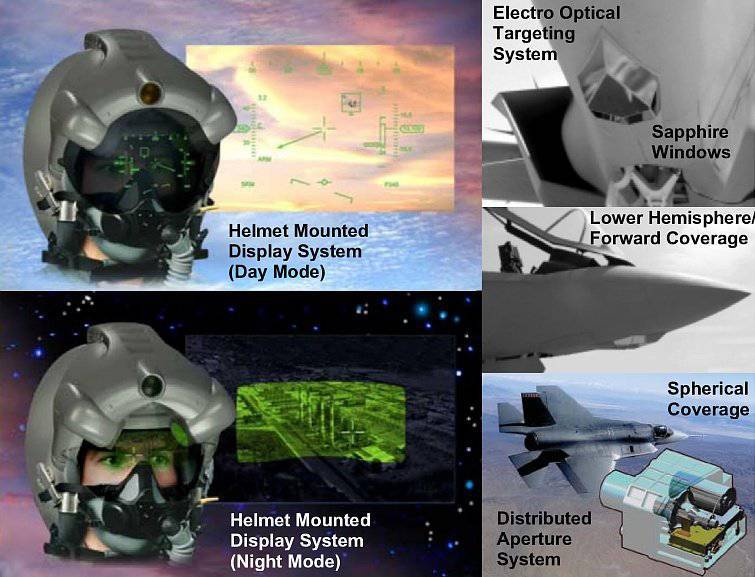
In all that concerns electronics, "Lightning" out of competition.
6. Radar station with phased antenna array (PAG).
Modern combat aviation switches to radars with active headlights - the advantage of such systems is their reliability and increased sensitivity. A large number of AFAR receivers allows the radar to continuously monitor dozens of air targets and simultaneously perform mapping of the underlying terrain.
The result is the following alignment:
PAK FA - experimental radar with AFAR H050;
F-22 "Raptor" - radar with AFAR AN / APG-77;
F-35 "Lightning-2" - radar with AFAR AN / APG-81;
Su-35 - equipped with a radar with a passive HEADLIGHT H035 "Irbis". Due to its power and technological excellence, the Irbis is in no way inferior to the Raptor radar in detecting air targets.
The Multipurpose Lightning fighter with its AN / APG-81 stands alone. For the creation of this radio engineering miracle, the Northrop Grumman development team could seriously claim to receive the Nobel Prize.
The APG-81 radar's mass is less than 1% of the F-35 take-off mass, but this device determines the combat capabilities of the aircraft. Lightning radar has modest dimensions and aperture (antenna dimensions), therefore, objectively, it is inferior to Irbis and APG-77 in the range of detection of air targets. It was originally intended: light multipurpose "Lighting" is not a specialized interceptor.
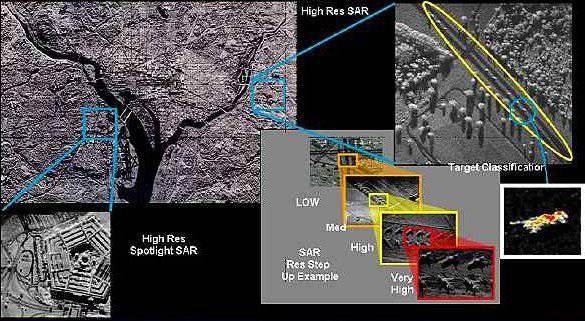
"Shadows" should not be misleading: there is always such a moment on radar images
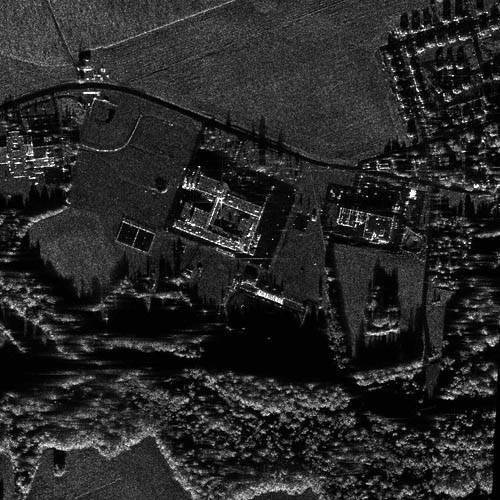
The radar complex of the front-line fighter, first of all, is focused on performing tasks in the air-to-surface format. Synthesis of the aperture (the mode of operation in which there is an “artificial” increase in the width of the radiation pattern by coordinated signal processing), coupled with high sensitivity of the AESA - all this makes it possible to obtain images of the earth's surface with an incredibly high resolution. The APG-81 is capable of detecting at a great distance and taking dozens of ground targets for tracking, automatically identifying them and directing weapon. Other features of the APG-81 include stealth mode with passive data collection, operation as an electronic intelligence station and an electronic warfare station.
The penalty score received by the F-35 for the “small” aperture of its radar antenna can be easily interpreted in 10 positive ratings.
7. Side view antennas.
There is a clear advantage for the PAK FA - the Sukhoi design bureau experts plan to equip their flying masterpiece with an integrated radar system with five AFARs, four of which are located in the slats. This will increase the noise immunity and neutralize the stealth technology opponents PAK FA.
Initially, two side-cover AFARs were planned to be installed on the American Raptor, but the proposal did not receive development due to the exorbitant cost of such a system.
As for the F-35 - “Lightning” is deprived of radar with side-view antennas, but it has its own know-how ...
8. Situational awareness.
The F-35 does not have side-view radar; instead, an all-advanced AN / AAQ-37 Distributed Aperture System (DAS) detection system operating in the infrared range is installed on board. Six DAS sensors are able to detect the jet torch of an enemy aircraft at a distance of hundreds of kilometers, leveling all attempts to reduce visibility in the range of radio waves. The system allows you to make low-altitude supersonic throws at night, to warn the pilot about the missiles launched by the enemy, calculate the launching points of the missiles and the anti-aircraft artillery positions, detect the ballistic missile torches at a distance of 1300 km!
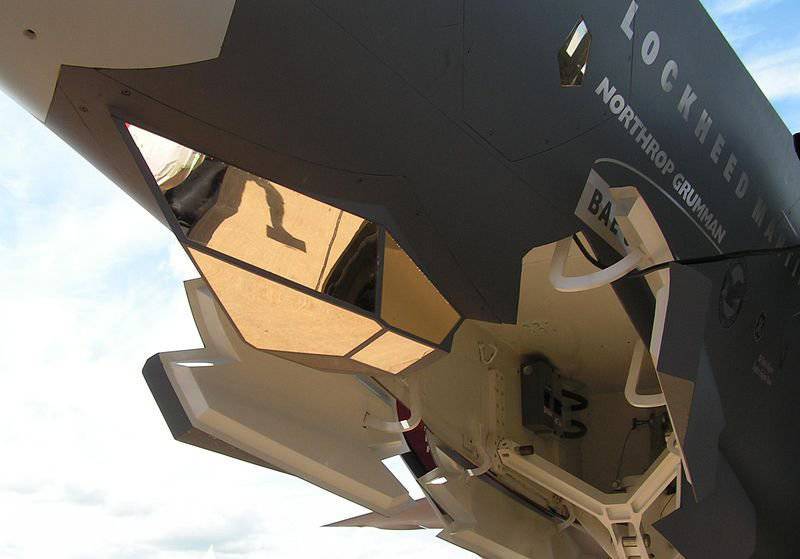
In addition to the unique AN / APG-81 radar and DAS system, the fighter is equipped with an AN / AAQ-40 high resolution infrared TV camera capable of detecting the heat of a passing car and the embers of an extinct campfire. The camera provides automatic capture and tracking of any air, ground and surface objects.
All this is complemented by a widescreen touchscreen display in the cockpit with mixing (overlay) of the incoming information. As well as the helmet-based target designation and display system HMDS, with the ability to control the rotation of the head and, in perspective, the illusion of a "transparent" aircraft.
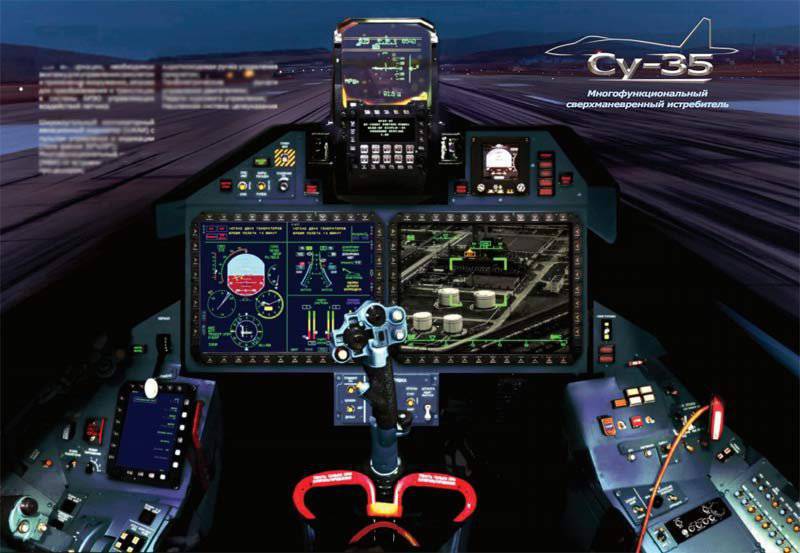
It is strange that Carlo Kopp disregarded all of these technologies, equating Lightning to the Chinese dummy J-20.
9. The possibility of using weapons on supersonic.
We are talking about the possibility of opening the wings of the weapons bays at high speed. According to experts, this advantage will have only one fighter of the "fifth generation" - the Russian PAK FA. The design of the other "Raptors" does not imply the use of weapons at supersonic speeds.
For Su-35, this item does not matter, since there is no built-in bomb bay.
F-35 received its legitimate "minus".
10. Thrust-to-weight ratio
Of course, the F-35 was again wronged - the conclusion about its low thrust (0,8) is evident from the official press releases of Lockheed Martin. The remaining machines with thrust-weight ≈ 1, received an equal rating.
11. Combat ceiling (where possible maneuvers with an established reversal speed of more than 7 degrees / sec.)
According to Carlo Kopp, the F-35 combat ceiling does not exceed 45 thousand feet (13700 m) - 3 is less than a kilometer less than its competitors. So it is in reality, or Air Power Australia again provides incorrect information - it has little value in the era of anti-aircraft missile systems and the general transition of combat aircraft to low altitudes (the trend was set back in the distant 60s, hello to Mr. Powers!)
F-35 received a penalty score. Just in case.
12. Stealth.
By a strange coincidence, opposite the F-35 is the inscription "Partially." Of course, Lightning is not an invisible hat and will suffer losses from the effects of enemy fire. But if you look at his rivals - “Raptor” and the PAK FA, their advantage over “Lightning” is not as obvious as Carlo Kopp believes. The layout of the PAK FA with protruding engines and “fins” of air intakes suggests that, when it was created, the “stealth” parameter played a far from central role.
Purely logically, "Lightning" should have the smallest ESR among all existing fighters, with the exception of the F-22. This is facilitated by:
- the small size of the fighter (wingspan of the entire 10,7 meter);
- diamond "flat" fuselage;
- parallelism of all faces and edges (“stealth” of the 2 generation);
- besperepletny cabin lantern;
- internal suspension of weapons;
- widespread introduction of radar absorbing coatings;
- computer-controlled assembly with reduced gaps and a small number of fasteners (CAD CATIA);
- “sawtooth” shape of the casements;
- the absence of radio-contrast parts on the surface of the wing and fuselage.
These measures are required to give a significant effect on reducing the visibility of the fighter (much less than 1 sq. Meter when irradiated from the frontal direction).
13. Fuel stock in internal tanks.
The advantage of Russian fighters - according to Carlo Kopp, the internal fuel supply of the Su-35 reaches 25 thousand pounds (over 11 tons!) - three tons more than is placed in F-35 tanks.
On the other hand, the F-35 is positioned as a lighter single-engine vehicle. The Pratt & Whitney F-135 engine has lower fuel consumption than two AL-41F1S engines.
Finally, the use of air-to-air refueling systems makes a further dispute over fuel reserves irrelevant.
14. Internal suspension weapons.
One of the main requirements for the "fifth generation fighter"! The internal suspension of weapons contributes to a radical decrease in the EPR of the aircraft and reduce its drag. In addition, it allows you to make more vigorous maneuvers and reach speeds up to 2M, without the risk of detonation of ammunition from heat.
All the aircraft on the list (with the exception of the Su-35) have the possibility of internal suspension of ammunition. The advantage of the Russian PAK FA is that due to its large size, the PAK FA bomb bay has the largest dimensions and capacity (length 5 meters, width 1,3 meter). As a result, the 8-10 suspension points against four of the F-35 fighter.
It is a shame that Carlo Kopp paid a lot of attention to the calculation of suspension points, but did not at all reflect in his table such an important point as the nomenclature of used ammunition.
In this ranking, the absolute advantage for the F-35. Planning the 119-kg Small Diameter Bomb, the Paveway laser-guided bombs, the JDAM GPS-guided munitions, the Mk.80 family of free-falling bombs, the CBU cluster munitions, the Mayric and JASSM cruise missiles for life times.
Combat load 8 tons on 10 suspension points (4 internal, 6 external), given its low profile and the latest sighting and navigation tools - F-35 can successfully compete with any tactical bomber.
And at the same time, the fighter remains a fighter - a unique radar, infrared circular vision system, AIM-120 AMRAAM long-range missiles, low-profile and low-level power at the level of the 4 + generation fighter. All this turns Lightning into a serious air rival.
The claims of Dr. Kopp are based on the weaker flight characteristics of the Lightning, compared with the Russian Dryers, traditionally distinguished by their excellent LTH. But you need to understand that Lightning was created under a completely different concept of warfare. Traditionally for Americans, the niche of light front-line fighters is occupied by multipurpose fighter-bombers, oriented to work "on the ground." And here there is absolutely nothing to blame F-35.
As it turned out, the reason for the loud confrontation between Air Power Australia and the aircraft corporation Lockheed-Martin was precisely the latter’s reluctance to export F-22. Carlo Kopp is not a fool. He is a sincere patriot of his country. And he tried with all his might to "knock out" for the Royal Australian Air Force a full-fledged Raptor interceptor fighter, the most satisfying of the defensive concept of the Australian armed forces.
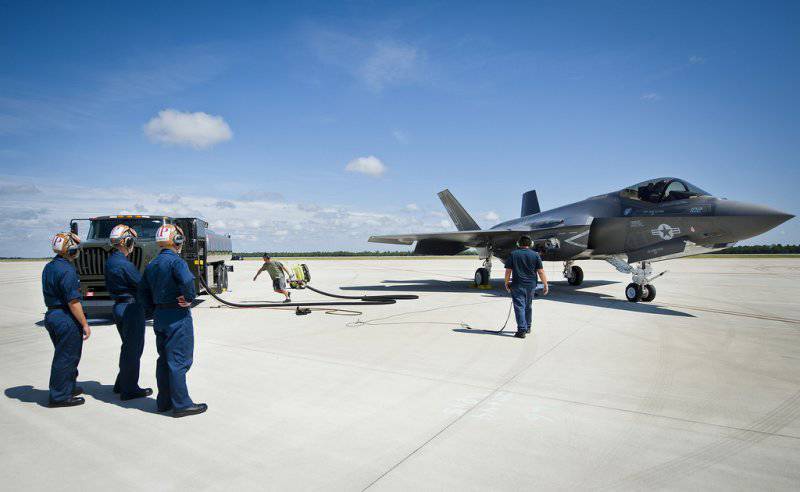
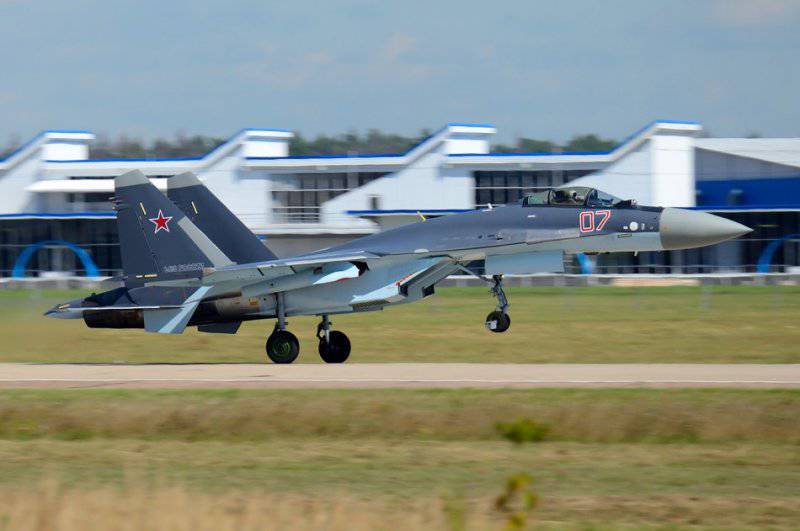
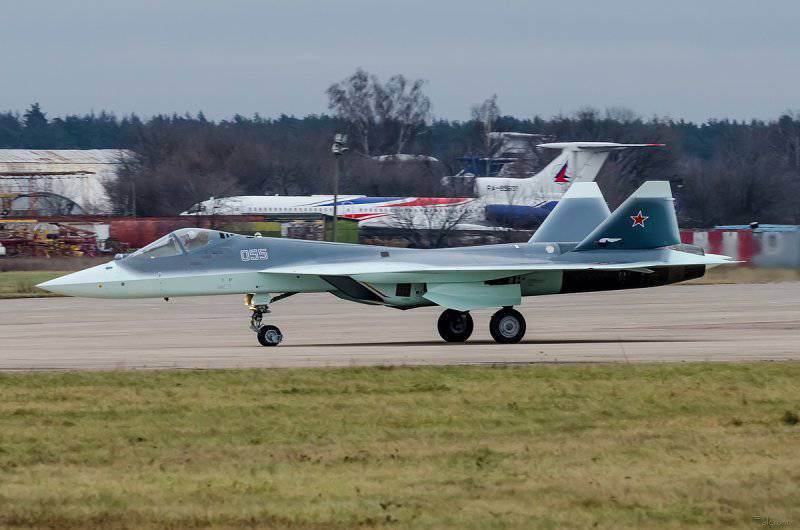
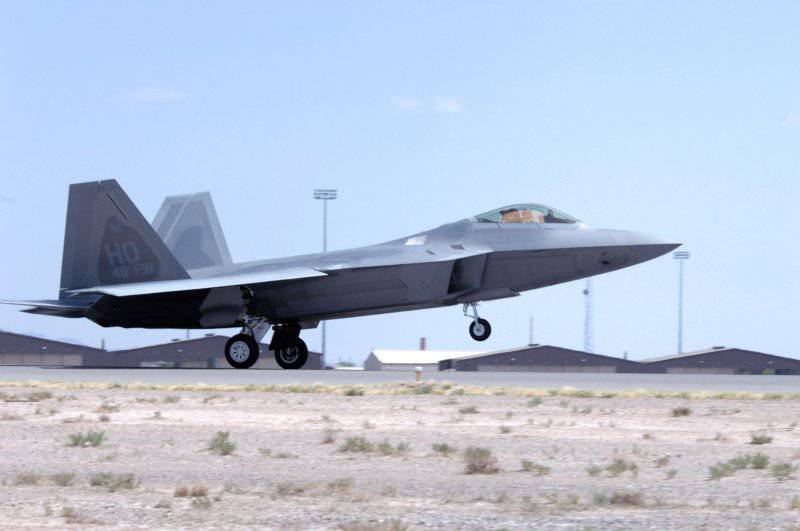
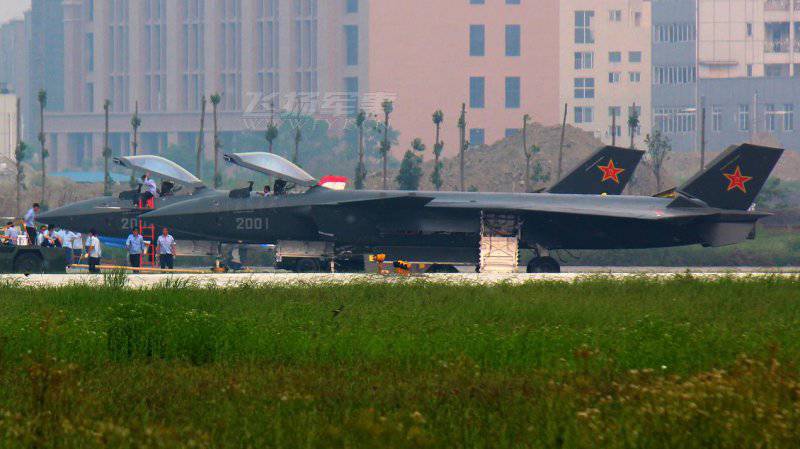
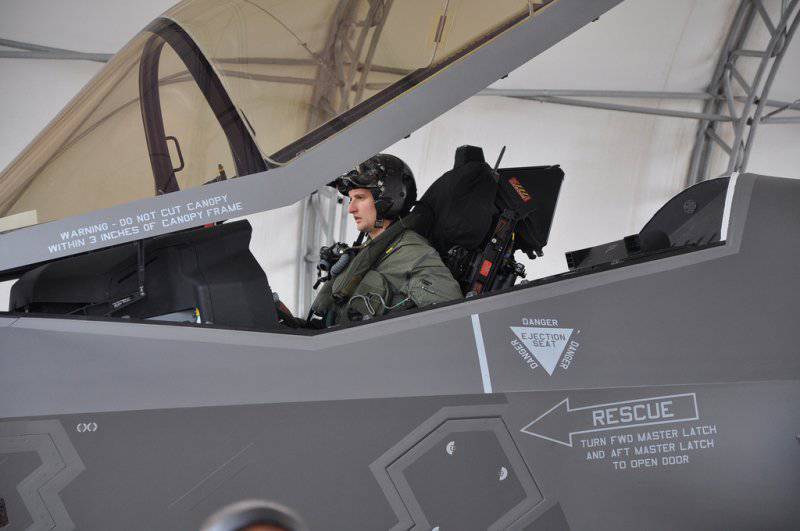
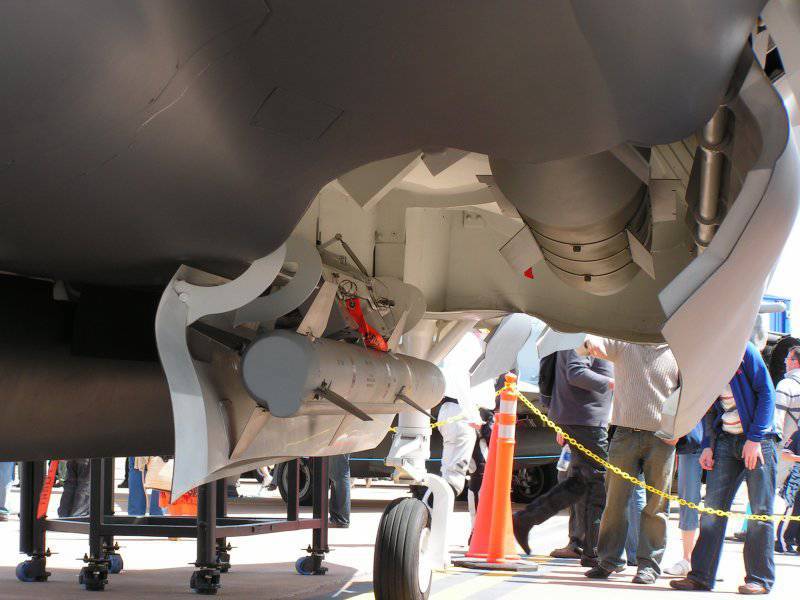
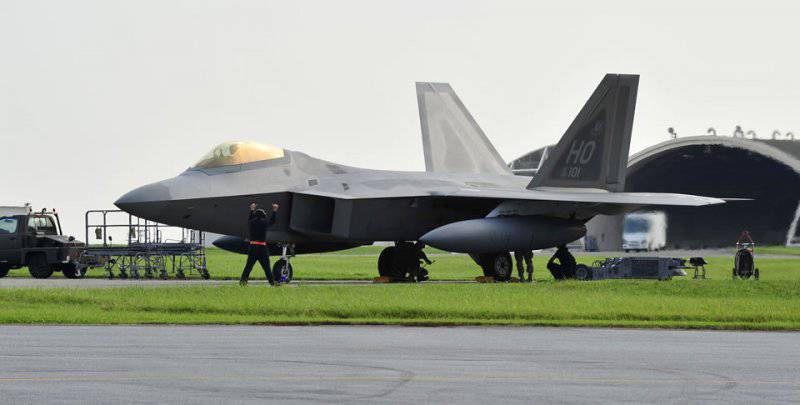
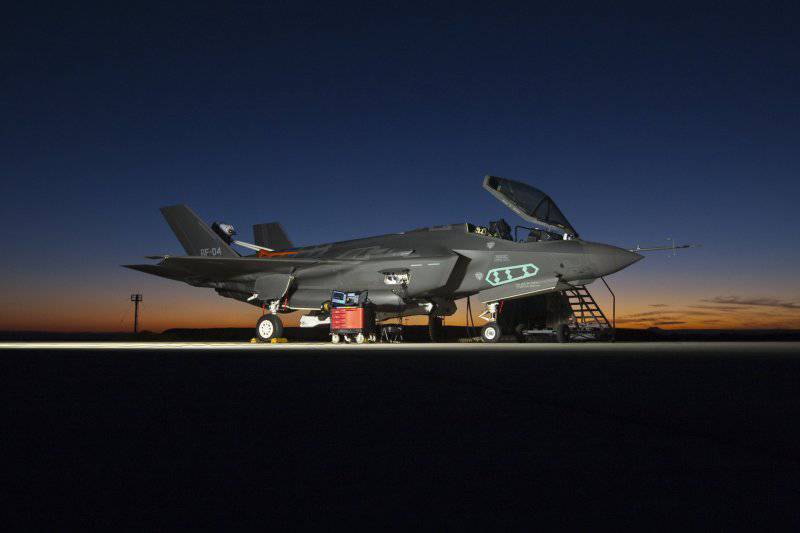
Information